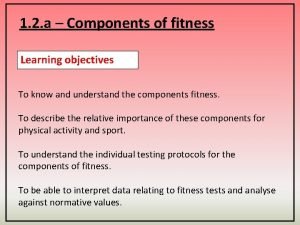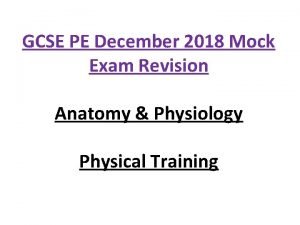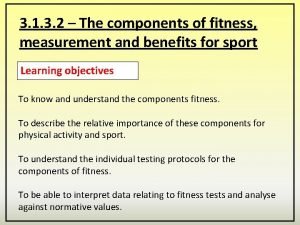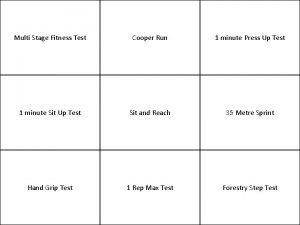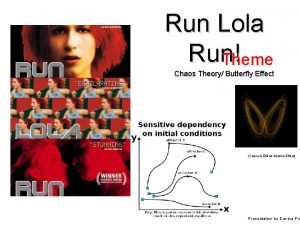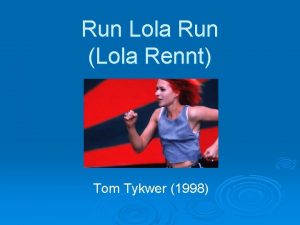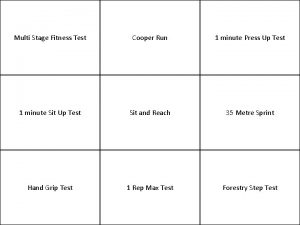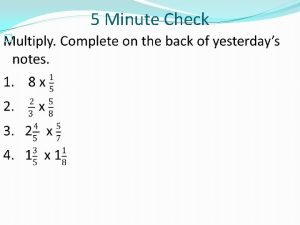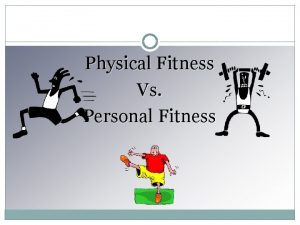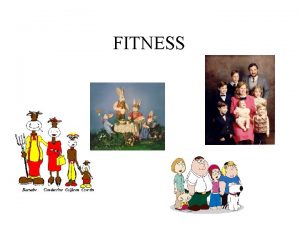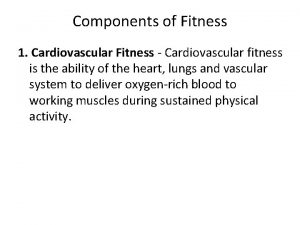Multi Stage Fitness Test Cooper Run 1 minute










- Slides: 10

Multi Stage Fitness Test Cooper Run 1 minute Press Up Test 1 minute Sit Up Test Sit and Reach 35 Metre Sprint Hand Grip Test 1 Rep Max Test Forestry Step Test

Measure the area you are using in metres. • Run continuously around this area for 12 minutes. • Count how many metres you have run over this time. • Complete as many full press ups as you can in one minute. • Have a partner record how many you did in this time. • Sit with your legs straight against the box • Measure 35 metres and mark • Lean forward and reach as far the start and finish with cones. as possible with your fingertips • Time your performance and • Measure in cm how far you can repeat 3 -5 times. reach • Do this 3 times and measure the 4 th stretch • Cones are placed 15 -20 m apart • You run between the cones to a series of bleeps. • These bleeps become progressively shorter as the test continues. • Measure the result (your VO 2 max) in ml/kg/min • • Similar to the bleep test. • Step up onto a bench and down according to the beat of a metronome (like the bleep test) • Continue this for 5 minutes. • Grip the dynamometer in your dominant hand • Hold it over your head • Squeeze and bring it down to your side. • Measure the result in kg • • • Choose a gym exercise (bench press, squat, deadlift etc). Complete 1 repetition with the most weight that you can in this exercise. Complete as many full sit ups as you can in one minute. • Have a partner record how many you did in this time.

BIA Jackson Pollack Nomogram Illinois Test Standing Stalk Test Wall Throw Test Ruler Drop Standing Broad Jump Standing Vertical Jump BMI

Take skinfold measurements of fat (men – chest, abs, thigh. Women – triceps, abs, thigh) • Using a ruler, draw a straight line through age of the individual to the sum of their skinfold. • Where this number crosses % body fat is the result • Set up the course of cones. • Lie face down at the start cone. • Complete the course as quickly as possible against the clock. • Hold a ruler in between the thumb and forefinger of an individual. • Drop the ruler and see where the individual catches it. • Repeat this 3 times and take the best result in cm • • . Stand on one leg with your foot resting on your knee. • Arms stretched to the side • Stand on your tip toes and close your eyes. • Time how long you can hold this in seconds. Use one tennis ball and throw against a wall from left to right. Count how many times you can do this in a minute. Stand side on to a wall, reach • with feet parallel along a start up and draw a straight line at line. the tips of your fingers. • Jump with 2 feet as far forward • Stand away from the wall and as you can. jump as high as possible, • Stay still as you land mark recording the point where your heels are. fingers touch. • Measure in cm. • The score is the difference in distance, measured in cm. • Weigh the individual in kg • Measure the individual in cm • Calculate bmi using the equation: • Weight (kg) / height²Stand Attach electrodes to the wrist and ankle of an individual on the same side of the body. • Run an electrical current through the individual. • Body fat reduces flow of current, so the more current needed, the greater % body fat • •

Frequency Intensity Time Type Specificity Progressive Overload Adaptation Reversibility Variation

• How long each exercise lasts • • • Training at an appropriate intensity and increasing the amount of stress we put on our bodies to improve Varying a training programme will stop boredom from occurring • How hard the exercise is • Focusing on activities relevant to someones sporting goals or needs • Our bodies need to be placed under stress to improve. If they are not then previous gains will be reversed. How many times you train a week • The nature of the exercise that is being completed. • By progressively adapting, you are placing your body under stress and getting faster/stronger as a result.

Rest and Recovery Static Active Static Passive Dynamic/Ballistic PNF Free Weights Circuits Plyometrics Continuous Training

• Another person helps to apply the force that lengthen and stretches the muscles Strength exercises which put different muscle groups under strain. • Strength training – low reps high loads • Endurance training – high reps low loads • • Includes jogging, swimming, cycling for a minimum of 30 mins without rest. • • • . Our bodies need rest after activity to allow adaptation to occur. If we don’t this can cause injuries. • Momentum is used to force the muscles past their normal range of movement using fast jerky movements. The performer applies the force that lengthens and stretches the muscles. A partner or object helps to provide resistance and push the joint further than it can be stretched. • It is held in an isometric contraction for 6 -10 seconds. • Then relaxed • Improves strength and power • Includes box jumps, skipping, hopping and bouncing • Forces the quadriceps and hamstrings to shorten quickly and provide power Series of exercises arranged in order to develop fitness. • Can be used for strength and cardio vascular endurance •

Fartlek Training Interval Training Hollow Sprints Acceleration Sprints Interval Training Maximum Heart Rate Training Pyramid Borg RPE Scale

• . Similar to interval training • where sprints are broken up by a ‘hollow’ period of jogging/walking. Alternating between periods of running for a set time, and resting for a set time. • Speed play • Form of continuous training where you vary pace, terrain and resistance Running speed is increased from jogging to striding to sprinting at maximum pace over a distance. • • 220 - age =? ? Periods of sprinting followed by set rest periods. • • Scale that shows rate of perceived exertion. • Rated between 6 -20 • 6= low effort • 20= max effort • Number x 10 = rpe Aerobic zone: 60 -85% • Anaerobic zone: 85 -95% • Speed zone: 95 -100% •
 Normative data for ruler drop test
Normative data for ruler drop test Multi stage fitness test
Multi stage fitness test Ruler drop test normative data table
Ruler drop test normative data table Fartlek pyramid
Fartlek pyramid 1 minute to seconds
1 minute to seconds Example of skill-related fitness
Example of skill-related fitness Single channel single phase example
Single channel single phase example Multi loop pid controller regolatore pid multi loop
Multi loop pid controller regolatore pid multi loop Short run equilibrium under perfect competition
Short run equilibrium under perfect competition Run lola run butterfly effect
Run lola run butterfly effect Run lola run editing techniques
Run lola run editing techniques
